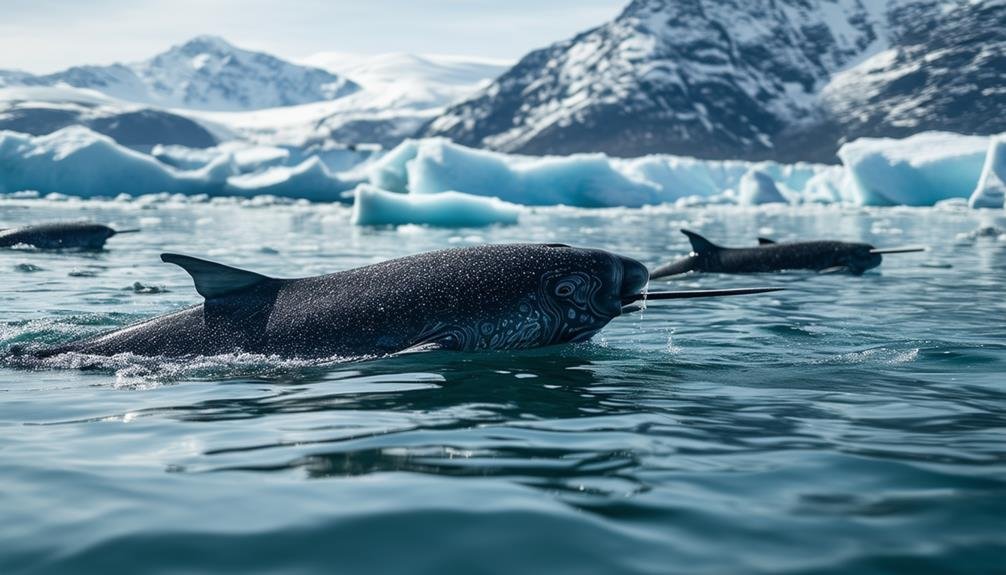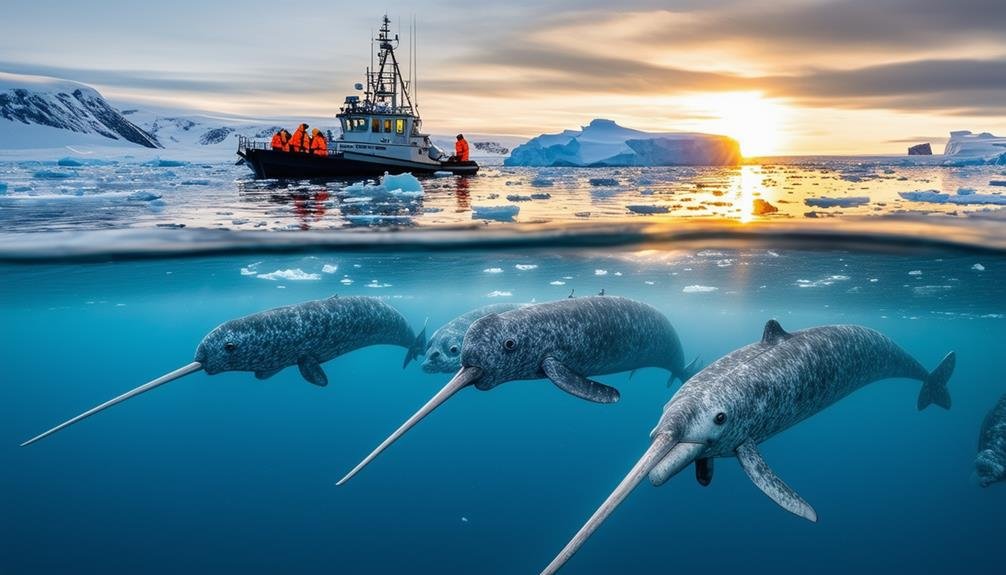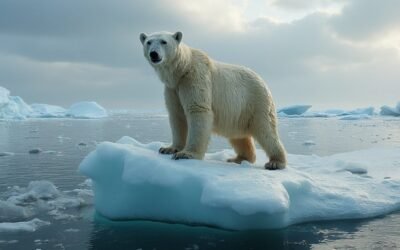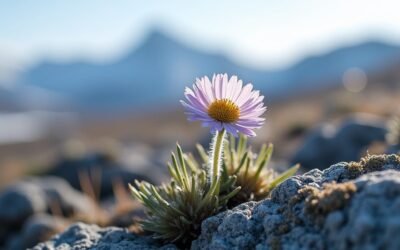Narwhals are vital to the Arctic ecosystem, acting as indicators of environmental health and significant players in food web dynamics. They control prey populations, aiding in nutrient cycling, and serve as prey for top predators like polar bears and killer whales. Climate change poses severe threats, altering their migration routes and impacting reproductive success. Conservation efforts including marine protected areas and responsible tourism are essential for their survival. Research reveals insights from narwhal tusks, which encode climate change signals and dietary history. To gain a deeper understanding of narwhals' role and the challenges they face, continue exploring this topic.
Main Points
- Narwhals serve as indicator species, reflecting the health of Arctic ecosystems.
- Their migratory patterns facilitate nutrient cycling essential for ecosystem balance.
- Narwhals control prey populations, maintaining food chain dynamics.
- They are a crucial prey species for polar bears and killer whales.
- Climate change-induced shifts in narwhal behavior highlight broader environmental impacts.
Unique Physical Traits
How do the unique physical traits of narwhals enable them to thrive in the harsh Arctic environment? Narwhals exhibit several remarkable physical adaptations that are essential for their survival in the frigid waters of the Arctic. One of the most distinctive features of narwhals is their long, spiral ivory tusks, which can extend up to 10 feet. These tusks, fundamentally elongated incisors, serve various functions, including sensory perception and social interaction.
Another notable adaptation is their lack of dorsal fins. This absence reduces heat loss and allows narwhals to navigate efficiently beneath ice-covered waters, enhancing their survival strategies. Coupled with short flippers, this unique trait aids in precise navigation through the complex and often treacherous Arctic environment.
Narwhals also employ specialized feeding methods, such as using their tusks to stun prey and suction feeding, which involves creating a vacuum to ingest food efficiently. These innovative techniques exemplify their unique traits and are crucial for securing nourishment in an environment where resources can be scarce.
Ecological Significance
Beyond their unique physical traits, narwhals play an essential role in maintaining the health and balance of Arctic marine ecosystems. These enigmatic creatures are more than just a marvel to behold; they are integral to the intricate web of life in the Arctic. As top predators, narwhals regulate the populations of their prey, thereby influencing the entire food chain and ensuring the overall health of marine species in their habitat.
Narwhals' ecological significance can be summarized as follows:
- Indicator Species: By reflecting changes in sea ice conditions and Arctic environments, narwhals provide vital insights into ecosystem health.
- Trophic Dynamics: Their predatory habits help control prey populations, which impacts the food sources and reproductive success of other species.
- Nutrient Cycling: Migration patterns of narwhals facilitate the distribution of nutrients across Arctic waters, promoting a balanced ecosystem.
- Prey for Top Predators: Serving as prey for polar bears and killer whales, narwhals are important in maintaining the balance between predator and prey populations.
Understanding narwhals' roles in these areas allows scientists to monitor the health of Arctic ecosystems more effectively. Their sensitivity to changes in sea ice conditions makes them invaluable for evaluating the impact of environmental fluctuations on overall ecosystem balance.
Climate Change Effects

Climate change is profoundly affecting narwhals by altering their migration routes and feeding patterns in the rapidly changing Arctic environment. The decline in Arctic sea ice due to rising temperatures is disrupting these cetaceans' traditional migratory paths, forcing them to adapt to new routes that may not be as abundant in prey. Consequently, narwhals experience significant challenges in maintaining their feeding patterns, impacting their overall health and energy reserves.
The rapid habitat changes in the Arctic are also threatening narwhals' reproductive success. Warmer waters and receding ice cover are altering the ecosystem, making it increasingly difficult for narwhals to find safe breeding grounds. These changes can lead to a decline in calf survival rates, further jeopardizing the species' numbers.
The impacts of climate change on narwhals are occurring at a rate three times faster than the global average, underscoring the urgency of understanding and addressing these issues. Conservation efforts are critical to mitigating these impacts and ensuring the long-term survival of narwhals within the Arctic ecosystem. Thorough research into how climate change affects narwhals is essential for implementing effective strategies to protect this unique species and its habitat.
Conservation Efforts
Addressing the profound effects of climate change on narwhals necessitates robust conservation efforts focused on protecting their unique Arctic habitats. These efforts are pivotal in mitigating the adverse impacts of habitat degradation and pollution on narwhal populations. Marine protected areas are instrumental in preserving narwhal populations, ensuring they continue to serve as essential indicators of Arctic ecosystem health. To effectively safeguard these creatures, a multi-faceted approach is necessary:
- Marine Protected Areas: Establishing and enforcing marine protected areas helps shield critical narwhal habitats from human disturbances and environmental threats.
- Research and Monitoring: Continuous research and monitoring programs are vital for evaluating narwhal populations and identifying emerging threats, such as pollution and habitat degradation.
- Responsible Tourism: Promoting responsible tourism practices, including minimizing vessel traffic in narwhal habitats, reduces human-induced stress and disturbance.
- Collaboration: Fostering collaboration among governments, conservation organizations, and local communities ensures a cohesive and effective strategy for the long-term survival of narwhals and the broader Arctic ecosystem.
Research and Discoveries

Recent research and discoveries have greatly improved our understanding of narwhals and their role within the Arctic ecosystem. Narwhals play a critical part in the Arctic marine environment, and new research has shed light on their adaptive responses to the changing Arctic. Tusk analysis, a groundbreaking technique, provides valuable historical data on narwhals' diet and mercury levels. This method reveals a shift in their diet from Arctic species to open-ocean species, which impacts their energy intake and overall health.
Moreover, narwhal tusks have been found to encode climate change signals, reflecting alterations in sea ice cover and other environmental changes. Research shows that studying these tusks offers insights into broader climate change impacts on Arctic ecosystems. By understanding these changes, scientists can better predict the effects on narwhals' survival and reproductive success.
Additionally, the narwhals' complex communication system is another area of interest. It is believed that changes in sea ice cover may disrupt their ability to find Arctic food and communicate effectively. Overall, the research provides valuable perspectives on how narwhals and the broader Arctic marine ecosystem are adapting to rapid environmental changes.
Conclusion
To sum up, narwhals play a crucial role in Arctic ecosystems through their distinctive physical characteristics and ecological importance. The impacts of climate change on their habitats require strong conservation efforts. Ongoing research and findings are vital to comprehend and lessen the impacts of environmental changes on these marine mammals. A thorough strategy for conservation can aid in securing the survival of narwhals and preserving the harmony of Arctic ecosystems.


